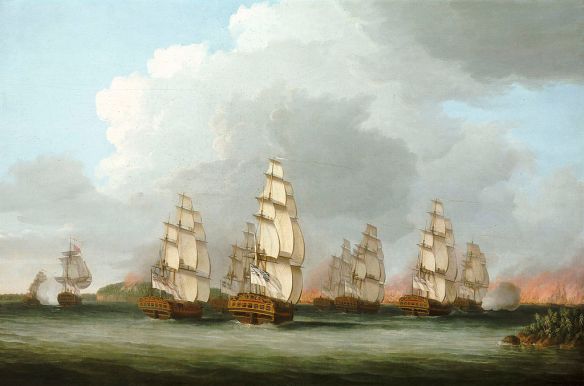
Britain defending New Ireland from the Penobscot Expedition by Dominic Serres.
A 1785 map depicting this action. The map is in mirror image (the Penobscot River is actually west of the Majabigwaduce peninsula, where the fort is located) and not to scale.
With its long indented coastline, bays, lakes, and rivers, the North American continent has always lent itself to waterborne operations, which were an essential part of military campaigns from the beginning of European colonization. Colonial and United States military and naval forces conducted many river crossings, operations on inland lakes, riverine operations, and small-scale amphibious raids in their long history. A series of expeditions beginning in 1645 by British and colonial troops against the French settlement of Port Royal in what would later become Nova Scotia is among the earliest recorded amphibious operations by Europeans in North America. In 1690 Sir William Phips led some 450 colonial militiamen in the seizure of Port Royal during King William’s War (the War of the League of Augsburg). Later that same year he failed to capture Quebec with a much larger expedition. Colonial troops also participated in Admiral Edward Vernon’s generally unsuccessful amphibious operations in the Caribbean during the War of Jenkins’ Ear (1738–48).
In 1745, 4,200 Maine volunteers, led by William Pepperrell, sailed in 90 ships to capture the French fortress of Louisburg on Cape Breton Island. Louisburg was returned to France under the provisions of the Treaty of Aixla-Chapelle, but in 1758, during the French and Indian War (Seven Years War), General Jeffrey Amherst and Admiral Edward Boscowen recaptured the fortress with some 14,000 British regulars and American Rangers carried in 150 transports escorted by 40 fighting ships. The following year, General James Wolfe carried out a brilliant amphibious landing to seize Quebec, an operation that General Douglas MacArthur would use as an example in his arguments for the amphibious landing at Incheon (Inch’on) 191 years later. Some 4,000 Americans of Amherst’s New York forces also participated in Admiral Sir George Pocock’s amphibious assault on Havana in 1762.
The first eight American combatant ships of the Revolutionary War were ordered into service by General George Washington as commerce raiders and manned by Army troops, many of them soldiers of General John Glover’s 14th Massachusetts Continental Regiment (The Marblehead Mariners). Under Commodore Esek Hopkins, 250 sailors and marines who raided the British port of New Providence in the Bahamas in March 1776 carried out the first American amphibious operation. The only other amphibious operation of any size during the Revolutionary War took place in 1779 when an expedition of 40 ships and 21,000 soldiers, sailors, and marines, under the joint command of General Solomon Lovell and Commodore Dudley Saltonstall, made an unsuccessful attempt to recapture the Castine Peninsula on Penobscot Bay, Maine. However, Continental Navy ships and craft and Continental Army forces carried out frequent coastal defense operations and used lakes and rivers for transportation. Indeed, an iconic image of the Revolutionary War is that of Washington being rowed across the Delaware River by soldiers of Glover’s regiment.
Following the Revolution, river transportation sustained Anthony Wayne’s 1792–93 Ohio campaign and the Lewis and Clark exploratory expedition to the Pacific coast. Throughout the War of 1812, American forces carried out coastal, lake, and river operations. These actions saw some of the best and the worst examples of the then-standard American approach to command and control in joint operations: the principle of voluntary “mutual cooperation,” with the land and naval commanders of equal status, neither subordinate to the other, and the effectiveness of the operation depending on the willing cooperation of each with the other. The height of effective cooperation was reached in October 1813 during the Battle of the Thames, when Commodore Oliver Hazard Perry, having swept the British from Lake Erie, supported Major General William Henry Harrison’s forces with naval gunfire and over-the-shore logistics. Perry then turned command of his squadron over to Captain Jesse Elliott and went ashore to serve at Harrison’s side during the ensuing campaign. The actions of Commodore Isaac Chauncey the following year were in stark contrast. Following effective but troubled Army–Navy cooperation in the attack on Sackett’s Harbor, Major General Jacob Brown called on Chauncey to support the Niagara campaign in July and August 1814. The commodore replied that, while
You might find the fleet somewhat of a convenience in the transportation of Provisions and Stores for the use of an Army and an agreeable appendage to attend its marches and counter marches . . . the Secretary of the Navy has honored us with a higher destiny—we are intended to Seek and fight the Enemy’s fleet . . . and I shall not be diverted in my efforts to effectuate it by any Sinister attempt to render us subordinate to or an appendage of the Army.